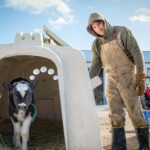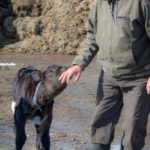A Family Farm in the Economic Sweet Spot
Consistent size of farm and herd helps the Fontaines keep a tight grip on quality control, which pays off financially too.
By Jamie Cole | Photos By Jamie Cole
Jim and Steve Fontaine walk up the path from Bartz Road, just outside the tiny township of Strykersville, N.Y., toward the milking parlor, open-air barn and silos that make up Fontaine Farms’ highly regarded dairy operation. The puddles in the driveway have frozen in the last hour. The late-winter sundown brings a shock-to-the-system sudden cold and a biting wind.
“Colder the better,” Steve says, laughing. Afternoon milking is finished and the fresh milk is cooling quickly—all the better when it comes to the quality for which the Fontaines are known. Faces are red and chapped, and it’s time to call it a day.
It’s March, and the snowbanks around the barn haven’t quite thawed. “They get pretty brown around this time of year because you’ve been pushing them around all winter,” says Jim. Today, though, “everything’s just nice and bright and white,” he says. “The farm looks pretty good in the snow.”
There’s a lot of white stuff in these parts year-round. The brothers’ Strykersville farm sits in a region rich—and getting richer—in milk production. New York is the country’s third-ranked dairy state, and Wyoming County is New York’s top-producing county, and a top 20 county in the United States.
Annual output in the area is more than a billion pounds of milk. Everything milked here is shipped somewhere else for processing, much of it to neighboring counties where cooperatives churn out high-quality dairy products that ship worldwide. The Fontaines pool their milk with the 350-farm-strong Upstate Niagara Cooperative, which produces beverage milk as well as yogurts, dips, cheese and butter.
“We ship 7.5 million pounds a year,” says Jim, “and we have three full-time guys: my brother, my son [Jacob] and me.”
The dairy herd in Wyoming County is upward of 50,000 head. The Fontaines milk 300. They have 40 dry cows and around 250 replacement heifers. They feed off 900 acres of combined corn silage and haylage, and supplement with some purchased grain. “You get out in the county, it seems like dairies keep getting bigger,” says Jim. “And everybody asks me, ‘When are you going to get bigger?’”
It’s a question that would give most dairymen—and businessmen in general—pause. But after talking to the Fontaine family, it’s easy to imagine what a business meeting at Fontaine Farms LLC might sound like: “Keep doing what we’re doing. Hold the line.”

Jacob describes his responsibility to the family business this way: “You know, if you’re going to raise a calf, just keep that calf healthy and keep it on its feet, doing a good job from day one, right up till she’s ready to birth another calf.”
Meeting adjourned. “I don’t really care to get bigger,” Jim says. “I milk my own cows.”
Doesn’t everyone? Not quite. In fact, studies show that skilled labor—or the lack of it—is one of the most conspicuous factors in the eventual quality of the product. “Usually the guys who have the bigger dairies rely on all hired labor,” says Jim.
“Jim, Jacob and I are the only ones that milk,” says Steve. “We know what’s going on with the cows.”
You can’t teach intuition to hired labor. And sensing potential problems intuitively is working out quite well in terms of quality for the Fontaines. Last winter, the business was coming off three straight years as a National Dairy Quality Award winner, and until this summer, they were riding a streak of more than 70 months straight of somatic cell counts (SCC) below 100,000.

The national SCC average in shipped milk is trending downward,
while the Fontaines maintain counts below 100,000. CLICK to enlarge.
SCC is the barometer of milk quality. Elevated SCC is an indicator of mastitis, easily the most costly disease in the American dairy herd. Not only does it lead to poor-quality milk, it leads to less production, as its clinical symptom is inflamed mammary glands.
“I know when a cow comes in, if she’s off,” Steve says. “I can sense if there’s a problem with her. So if she does have mastitis, she is treated, or beefed—taken care of without contaminating the rest of the milk.”
As dairies in New York and nationwide either get much bigger, generating bulk product, or much smaller—crafting specialty, added-value “farmstead” goods—the Fontaines have found that their herd-size comfort zone is an economic sweet spot too. In fact, they count on their ability to manage quality as a way to manage income. The cash premium from Upstate Niagara for product of the Fontaines’ standard is significant, adding tens of thousands to the bottom line each year.
“I think the way we’re set up now, we’re running as efficiently as we can,” says Jim. “We just keep doing what we’re doing. And our accountant says keep doing what we’re doing. I guess we’re doing something right.”
The Fontaines believe their animals appreciate that consistency too. “You take them out of the routine and they get miserable,” says Jim.
Cow comfort starts with bedding, and the Fontaines take stall bedding seriously. “We have mattresses in our stalls,” Jim says. They also mix in gypsum with sawdust, which helps keep the animals drier and cleaner, reducing pathogens and even odor. (Note: Some experts warn that gypsum in packed bedding can be dangerous, releasing high levels of hydrogen sulfide gas. Natural ventilation in the Fontaines’ open-air barn makes use of gypsum safer, and they add fresh bedding every three days.) Cleaner cows mean less prep time before milking, which means less stress in general on the animal.
“The less stressed she is, the more quality product she’s going to produce,” says Jim.
“It’s all about knowing your cattle, each cow,” says Ed Fontaine, the patriarch of the Fontaine clan, who has lived and worked on the property his whole life. Ed worked the heart of the acreage in the current farm as his father did before him.
In 1992, Ed, Jim and Steve began the generational transition by forming a partnership. “Steve, Dad and I were partners, equal alike,” says Jim. That arrangement continued until the late ’90s, when Jim and Steve began to purchase Ed out and rent land from him.
The philosophy of keeping a small herd and treating cows as individuals isn’t new to Ed. He points out the farmhouse window to the corner of the milking parlor, where a huge sign bears the quality award badges from years past. “I mean, those signs you see out there, they just started putting those out in 1992. And we had quality milk for years before that.”
Jim and Steve say they learned a great deal from their dad, especially the steady-as-she-goes approach. Maintaining herd size and quality doesn’t mean a dairy can avoid the highs and lows of the business in general (especially when it comes to notoriously volatile milk prices in the U.S.), but “low debt per cow helps you prepare for those highs and lows,” says Jim. They maintain low debt by keeping herd size consistent and “not building the business around rented land,” says Jim.
Ed still helps with fieldwork, and these days fills the role of proud father. “It seems like the farm has always been efficient. When I was running the farm, they’d say, ‘How do you do all that?’
“Work never hurt anybody,” Ed adds, and looking around the table at Jim and Steve at the end of a long, cold day, he says: “The boys work hard. We have all worked hard to get where we are.”
“We’ve done it ourselves for so many years,” Steve says. “And we see no reason to change that now.”
Related Articles
AGCO Equipment Helps This Family Farm Do More Work with Less Labor

A full shed of AGCO tractors, haying, tillage and planting equipment gets the job done.
Read MoreNew Video From Fendt
Check out the new YouTube channel from Fendt, featuring FarmLife customer stories, equipment walkarounds, how-to content and more!
View It Now
Check out the new YouTube channel from Fendt, featuring FarmLife customer stories, equipment walkarounds, how-to content and more!
View It Now





